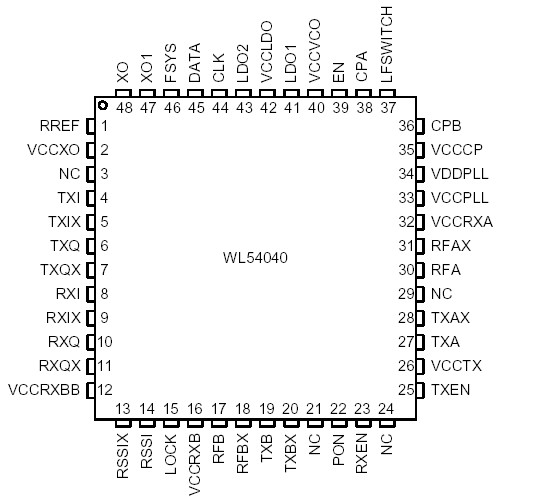Features: `Direct-conversion receiver for IEEE® 802.11b and low-IF receiver for IEEE 802.11a/g with integrated channel filter and programmable gain control.
`dc offset cancellation.
`Synthesizer with integrated VCO, PLL, 40 MHz crystal oscillator with digital frequency calibration.
`I-Q differential interface for RX and TX, multiplexed for IEEE 802.11a/b/g.
`Direct modulation transmitter with programmable output power 10 dBm to 0 dBm.
`High sensitivity (under normal operating conditions):
-IEEE 802.11b mode: 88 dBm for 11 Mbits/s.
-IEEE 802.11a and IEEE 802.11g modes:
74 dBm for 54 Mbits/s.
`No external SAW filter required.
`Low BOM, low external component count.
`0.25 µm BiCMOS technology.
`Three-wire bus control.
`Supply voltage 3.0 V-3.6 V.
`Alternative direct supply of regulated supply voltage 2.5 V-2.7 V.
`Two integrated voltage regulators (LDO).
`Powerdown modes.
`Operational temperature 30 °C to +85 °C.Application·High data-rate multimode applications.
·Client cards for notebooks, desktop PCs, and PDAs.
·Modules with WLAN functionality.
·Enterprise and home infrastructure devices.
·High-speed bridges and point-to-multipoint systems.
·Home entertainment and multimedia systems.Pinout Specifications
Specifications
|
Parameter |
Symbol |
Min |
Max |
Unit |
Parameter |
Symbol |
Min |
Max |
Unit |
Supply Voltage† (Except VCCLDO)
Supply Voltage for VCCLDO
Input Voltage
Differential Input Voltage |
VS
VSLDO
VI
VID |
0.3
0.3
0.3
- |
2.8
3.6
3.1
2.0 |
V
V
V
Vp-p |
Output Voltage
Open Collector Output Voltage
Total Power Dissipation(RthJA = 25 K/W)
ESD-integrity* |
VO
VOC
Ptot
VESD |
0
0.3
-
- |
VS
4.0
600
1000 |
V
V
mW
V |
* Stresses in excess of the absolute maximum ratings can cause permanent damage to the device. These are absolute stress ratings only. Functional operation of the device is not implied at these or any other conditions in excess of those given in the operations sections of the data sheet. Exposure to absolute maximum ratings for extended periods can
adversely affect device reliability.
† Supply voltage for all supply pins except VCCLDO (VCCXO, VCCRXBB, VCCRXB, VCCTX, VCCRXA, VCCPLL, VDDPLL, VCCCP, and VCCVCO).
DescriptionThe WaveLAN WL54040 is a low-power, high-performance dual-band transceiver for the IEEE 802.11a, IEEE 802.11b, and IEEE 802.11g wireless LAN standards. The WL54040 is designed to form a complete Agere IEEE 802.11a/b/g chip set in combination with the WL64040 multimode baseband processor, the WL60040 WMAC, and the WL54240 dual-band power amplifier.
The WL54040 is designed in 0.25 µm BiCMOS technology. It is capable of automatically switching between low intermediate-frequency conversion (low-IF) for OFDM and direct down conversion for DSSS/CCK modulation, enabling the device to achieve optimal throughput for all of the IEEE 802.11 standards. Specifically, low-IF conversion guards against dynamic range degradation, an inherent limitation of direct-down OFDM architectures, to provide improved system performance.

 WL54040 Data Sheet
WL54040 Data Sheet







